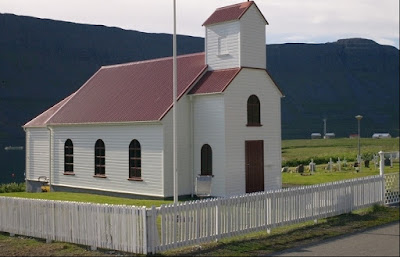Barra Island is one of the Outer Hebrides in western Scotland. Its main settlement is
Castlebay.
A sheltered bay provides a unique and astounding setting.
Kisimul Castle and Castlebay
The island of Barra is a predominantly Gaelic-speaking island.
Castlebay (Bagh a‘ Chaisteil), the main village on the island, got its name from
Kisimul Castle, propriety of
Historic Scotland. The History of Castlebay is deeply entwined with the story of the
Clan MacNeil, owner of the castle for 411 years.
No wonder it inspired several movie sets, and won "best village in Britain" title some years ago.
Castlebay grew as a thriving herring port in the 19th century, with up to 400 boats in its harbour and curing and packing factories ashore.
In the end of the 19th century, some improvement came with new houses, shops, a school, a post office and a bank – and the new church built in 1888.
A mostly well-known church, thanks to a TV show
Castlebay, Barra
Coordinates: 56º 57' N, 7º 29' W
Population : ~1000
The town centre: left the Post Office, then the Pier Road from the ferry pier up to The Square, at right.
Viewed from the castle. Tourism became the main source of income.
The Castlebay Hotel opened in 1894 !
The Hotel front overlooks the bay and the harbour:
Guest House '
Tigh Na Mara'
is established in a traditional stone house; as its Gaelic name suggests it's also located by the sea.
The historic uptown: The Square and the Church.
The Square is an early 19th century, two-storey house with an unusual central gable. It was built for some kind of storing. Though it has been classified, its condition is very poor.
Castlebay's Pier Road, running down from The Square.
Pier road leads to the waterfront ferry jetty, right in front of the Castle.
A few Cafés can be found here:
Café Kisimul
But the best in town for tea is
Macroon's Tearoom at the old Post Office:
With tea or coffee, this scone &al must taste delightful viewing the bay.
The Post Office, down by the harbour
Barra is quite recommended for learning Gaelic !
For such a small island it still has a surprisingly large number of children in school – around 80. And a surprisingly large offer of cultural activities!
The 'Screen Machine', a comfortable 80-seat digital mobile cinema, is brought by ferry to Castlebay.
The community now lives mainly of tourism, but farming (sheep) as much as its fishing activity are still active. Hotel occupation and smaller lodging facilities (as well as camping sites) as well as other services have been increasing. There is even (hard to believe) a little Cultural Centre - the '
Heritage Centre', featuring several exhibitions each year on local History, lifestyle and crafts.
The Dualchas opened in 1996 on main road.
www.barraheritage.com/dualchas
Situated towards the west end of the village, close to the school, the Centre displays artefacts, documents and photographs, and has built up extensive archives and collections.
The RNLI lifeboat "Edna Windsor" and a small trawler.
Castlebay is the most westerly lifeboat station in Scotland.
As a port, Castlebay developed because of the plentiful herring that shoaled these waters; from 1869 Castlebay became the centre of a fishing industry, with the associated gutting, curing and preserving facilities. The harbour conditions had improved in the 1890s with the building of the pier.
Herring barrel.
Nowadays, the main sea traffic into the port comes from the
CalMac ferries: (Caledonian MacBrayne)
The Castle
Kisimul Castle was built in the 1400s as a three-storey tower house, in which the Macneil clan chief lived. The Macneils, of Viking origin, settled in Barra in the 11th century. They were a seafaring clan, and probably dedicated to piracy.
The castle is built on a rocky islet in the bay, just off the coast. It can only be reached by boat.
Writing in 1549, Dean Monro stated of Barra that
"Within the southwest end of this isle, ther enters a salt water loche, verey narrow in the entrey, and round and braide within. Into the middis of the saide loche there is ane ile, upon ane strenthey craige, callit Kiselnin, perteining to M’Kneil of Barray."
Probably the most relevant feature in the island, this '
Castle in the Sea' has been carefully restored and maintained as a precious Heritage from History in the Hebrides.
The walls enclose a small courtyard with its ancillary buildings.
In 2001 the castle was leased by the chief of Clan MacNeil to
Historic Scotland for 1000 years for the symbolic annual sum of £1 and a bottle of whisky.
The
Church of Our Lady Star of he Sea (Stella Maris)
The
Church of Our Lady Star of the Sea, named for the patroness of those who sail the seas, sits on the south facing slopes that climb above Castlebay. The church opened on Christmas Eve 1888 when people from all over the islands gathered for Midnight Mass.
It's built in Gothic Revival style, with three aisles.
During the wars, the population of approx. 1100 people lost 125 men, killed in both World Wars. The side windows on the South facade are a homage to the Navy.
A beautiful stained glass work on the altar window, showing an angel descending towards what appears to be a warship.
















































































